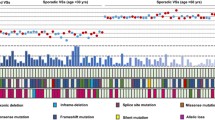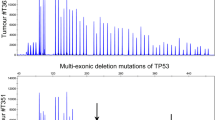Abstract
Recent studies have shed considerable light into schwannomas. To date, only merlin has been identified as a hallmark or pathogenesis of both sporadic and NF2-related schwannomas. Here, we show, by immunoblot and immunohistochemical analyses of 58 sporadic vestibular schwannomas, that upregulation of p53 was observed in 90 % of tumors examined. No p53 mutations were found in 12 % tumors analyzed. Expression of p14ARF was negative in 95 % of tumors, while overexpression of MDM2 was found in all specimens. Aberrant DNA hypermethylation of the p14ARF promoter was observed in three of seven tumors examined (43 %), associated with remarkably decreased mRNA levels. The very high degree of concordance in the aberrations of the p14ARF/MDM2/p53 pathway in this tumor may be considered to be a new player in the pathogenesis of sporadic vestibular schwannomas. Moreover, expression of p21 (waf1) was negative in all tumors, suggesting that the aberration of this pathway is associated with greater attenuation of p21-mediated signals that are critical for growth inhibition. These data are in agreement with the model in RT-4 rat schwannoma cells: i.e., overexpression of ARF was associated with accumulation of p21 expression both at protein and mRNA levels. ShRNA knock-down of p53 expression attenuated p21-mediated increase in cellular arrest in the G1-phase, suggesting that p14ARF regulates p21 protein levels through a p53-dependent pathway. Thus, this study reveals a high degree of concordance in the aberrations of the p14ARF/MDM2/p53 pathway with the development of sporadic vestibular schwannomas.



Similar content being viewed by others
References
Altomare DA, Vaslet CA, Skele KL, De Rienzo A, Devarajan K, Jhanwar SC, McClatchey AI, Kane AB, Testa JR (2005) A mouse model recapitulating molecular features of human mesothelioma. Cancer Res 65:8090–8095
Bar J, Lukaschuk N, Zalcenstein A, Wilder S, Seger R, Oren M (2005) The pi3 k inhibitor ly294002 prevents p53 induction by DNA damage and attenuates chemotherapy-induced apoptosis. Cell Death Differ 12:1578–1587
Brummelkamp TR, Bernards R, Agami R (2002) A system for stable expression of short interfering rnas in mammalian cells. Science 296:550–553
Chang Z, Guo CL, Ahronowitz I, Stemmer-Rachamimov AO, MacCollin M, Nunes FP (2009) A role for the p53 pathway in the pathology of meningiomas with nf2 loss. J Neurooncol 91:265–270
Dayalan AH, Jothi M, Keshava R, Thomas R, Gope ML, Doddaballapur SK, Somanna S, Praharaj SS, Ashwathnarayanarao CB, Gope R (2006) Age dependent phosphorylation and deregulation of p53 in human vestibular schwannomas. Mol Carcinogen 45:38–46
Derks S, Lentjes MH, Hellebrekers DM, de Bruine AP, Herman JG, van Engeland M (2004) Methylation-specific pcr unraveled. Cell Oncol 26:291–299
el-Deiry WS, Tokino T, Velculescu VE, Levy DB, Parsons R, Trent JM, Lin D, Mercer WE, Kinzler KW, Vogelstein B (1993) Waf1, a potential mediator of p53 tumor suppression. Cell 75:817–825
Fleury-Feith J, Lecomte C, Renier A, Matrat M, Kheuang L, Abramowski V, Levy F, Janin A, Giovannini M, Jaurand MC (2003) Hemizygosity of nf2 is associated with increased susceptibility to asbestos-induced peritoneal tumours. Oncogene 22:3799–3805
Jongsma J, van Montfort E, Vooijs M, Zevenhoven J, Krimpenfort P, van der Valk M, van de Vijver M, Berns A (2008) A conditional mouse model for malignant mesothelioma. Cancer Cell 13:261–271
Kalamarides M, Stemmer-Rachamimov AO, Takahashi M, Han ZY, Chareyre F, Niwa-Kawakita M, Black PM, Carroll RS, Giovannini M (2008) Natural history of meningioma development in mice reveals: a synergy of Nf2 and p16(ink4a) mutations. Brain Pathol 18:62–70
Kanellou P, Zaravinos A, Zioga M, Stratigos A, Baritaki S, Soufla G, Zoras O, Spandidos DA (2008) Genomic instability, mutations and expression analysis of the tumour suppressor genes p14(arf), p15(ink4b), p16(ink4a) and p53 in actinic keratosis. Cancer Lett 264:145–161
Kawamoto K, Enokida H, Gotanda T, Kubo H, Nishiyama K, Kawahara M, Nakagawa M (2006) P16ink4a and p14arf methylation as a potential biomarker for human bladder cancer. Biochem Biophys Res Commun 339:790–796
Lassaletta L, Torres-Martin M, San-Roman-Montero J, Castresana JS, Gavilan J, Rey JA (2013) DNA copy gains of tumor-related genes in vestibular schwannoma. Eur Arch Otorhinolaryngol 270:2433–2438
Lecomte C, Andujar P, Renier A, Kheuang L, Abramowski V, Mellottee L, Fleury-Feith J, Zucman-Rossi J, Giovannini M, Jaurand MC (2005) Similar tumor suppressor gene alteration profiles in asbestos-induced murine and human mesothelioma. Cell Cycle 4:1862–1869
Liu Y, Bodmer WF (2006) Analysis of P53 mutations and their expression in 56 colorectal cancer cell lines. Proc Natl Acad Sci USA 103:976–981
Martuza RL, Eldridge R (1988) Neurofibromatosis 2 (bilateral acoustic neurofibromatosis). N Engl J Med 318:684–688
Pager CT, Dutch RE (2005) Cathepsin l is involved in proteolytic processing of the hendra virus fusion protein. J Virol 79:12714–12720
Plotkin SR, Blakeley JO, Evans DG, Hanemann CO, Hulsebos TJ, Hunter-Schaedle K, Kalpana GV, Korf B, Messiaen L, Papi L, Ratner N, Sherman LS, Smith MJ, Stemmer-Rachamimov AO, Vitte J, Giovannini M (2013) Update from the 2011 international schwannomatosis workshop: from genetics to diagnostic criteria. Am J Med Genet A 161A:405–416
Rajaraman P, Wang SS, Rothman N, Brown MM, Black PM, Fine HA, Loeffler JS, Selker RG, Shapiro WR, Chanock SJ, Inskip PD (2007) Polymorphisms in apoptosis and cell cycle control genes and risk of brain tumors in adults. Cancer Epidemiol Biomarkers Prev 16:1655–1661
Sekido Y (2010) Genomic abnormalities and signal transduction dysregulation in malignant mesothelioma cells. Cancer Sci 101:1–6
Slack A, Chen Z, Tonelli R, Pule M, Hunt L, Pession A, Shohet JM (2005) The p53 regulatory gene mdm2 is a direct transcriptional target of mycn in neuroblastoma. Proc Natl Acad Sci USA 102:731–736
Stone S, Jiang P, Dayananth P, Tavtigian SV, Katcher H, Parry D, Peters G, Kamb A (1995) Complex structure and regulation of the p16 (mts1) locus. Cancer Res 55:2988–2994
Voorhoeve PM, Agami R (2003) The tumor-suppressive functions of the human ink4a locus. Cancer Cell 4:311–319
Warren C, James LA, Ramsden RT, Wallace A, Baser ME, Varley JM, Evans DG (2003) Identification of recurrent regions of chromosome loss and gain in vestibular schwannomas using comparative genomic hybridisation. J Med Genet 40:802–806
Woods R, Friedman JM, Evans DG, Baser ME, Joe H (2003) Exploring the “two-hit hypothesis” in nf2: tests of two-hit and three-hit models of vestibular schwannoma development. Genet Epidemiol 24:265–272
Wu H, Chen Y, Wang ZY, Li W, Li JQ, Zhang L, Lu YJ (2010) Involvement of p21 (waf1) in merlin deficient sporadic vestibular schwannomas. Neuroscience 170:149–155
Xirodimas D, Saville MK, Edling C, Lane DP, Lain S (2001) Different effects of p14arf on the levels of ubiquitinated p53 and mdm2 in vivo. Oncogene 20:4972–4983
Yi C, Wilker EW, Yaffe MB, Stemmer-Rachamimov A, Kissil JL (2008) Validation of the p21-activated kinases as targets for inhibition in neurofibromatosis type 2. Cancer Res 68:7932–7937
Acknowledgments
This work was supported by the Grant 2009CB521703 from 973 Program of China to Hao Wu and the Natural Science Foundation of China (30801286 and 30973307) to Hao Wu.
Conflict of interest
The authors declare that they have no competing interests.
Author information
Authors and Affiliations
Corresponding author
Rights and permissions
About this article
Cite this article
Chen, Y., Wang, Zy. & Wu, H. P14ARF deficiency and its correlation with overexpression of p53/MDM2 in sporadic vestibular schwannomas. Eur Arch Otorhinolaryngol 272, 2227–2234 (2015). https://doi.org/10.1007/s00405-014-3135-y
Received:
Accepted:
Published:
Issue Date:
DOI: https://doi.org/10.1007/s00405-014-3135-y




